How to buy, use and maintain heat pumps of all sizes to heat and cool your home with less electricity, to save money using heat pumps. How they work and when they are better than other ways of heating and cooling your home. ssssssssssssssssss sssssssssss ssssssssssss ssssssssssss sssssssssssss sssssssssss ssssssssss sssssssssss ssssssss
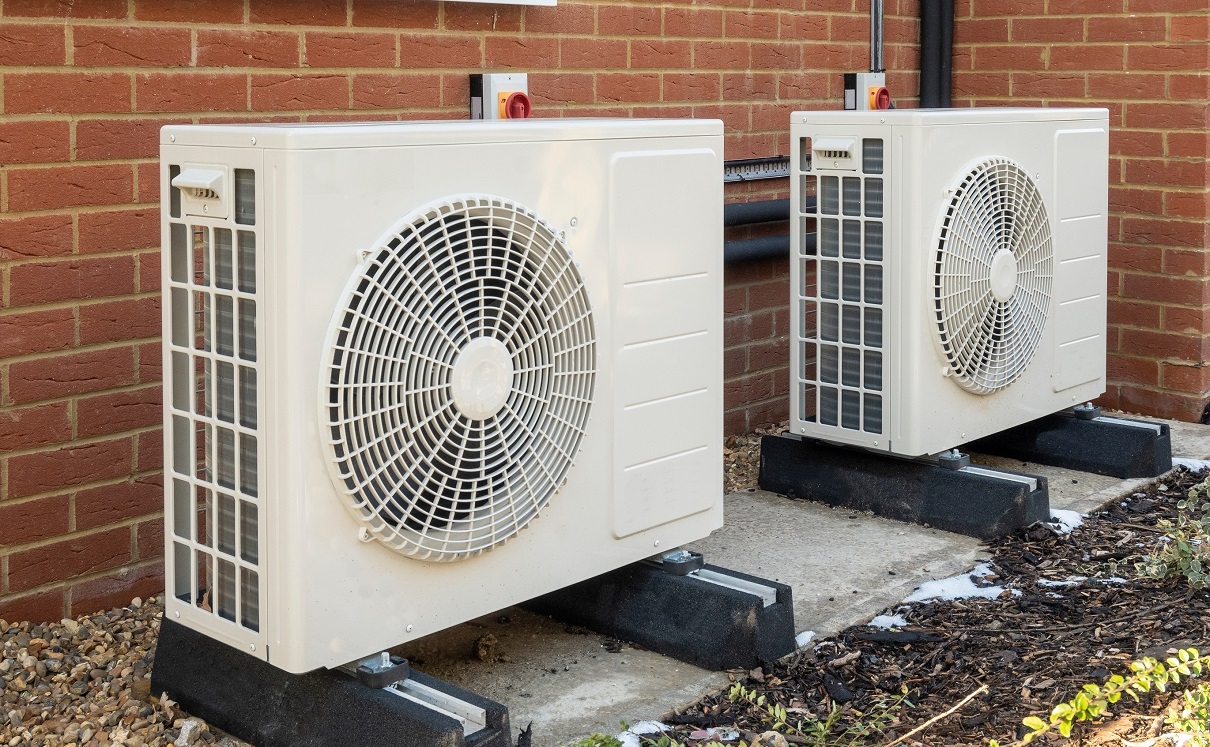
In the winter you can save money using a heat pump on days that aren’t too cold. In summer, heat pumps cool the home at a cost similar to central air conditioning. They are normally a good investment in moderate climates. There are many energy tips which can help you lower your electric bills when using a heat pump of any size or type.
B Table of Contents
B Other Posts on Home Energy
There are heat pump systems that transfer heat to and from a body of water such as a pond, and systems that transfer heat from the ground. Some heat pumps can dehumidify the home. The main disadvantage to heat pumps is that they can only be used on days when the outdoor temperature is not too cold and not too hot. See, How Do Heat Pumps Work?
Your yearly energy cost will depend on how many energy-saving features are on the model and whether use the heat pump efficiently. Some of these features are explained in Energy Tips for Buying a Whole House Heat Pump . Heat pumps don’t burn fuel to create heat, so there is no risk of carbon monoxide poisoning and there is no flame to worry about.
If you must replace both your air conditioning and your heating equipment, installing a whole house heat pump or a mini split heat pump system is much less expensive than buying conventional air conditioning and heating systems. A mini split system has the heating/cooling units mounted to exterior walls and have no HVAC ducts. They can be used to heat and cool a small house or a section of a house. This is explained in the section in Mini Split Heat Pumps.
When heating a home on a day that is not very cold, transferring heat energy from outside to inside costs less than generating energy in a furnace or other heating unit by burning fuel or using resistance electric heat. In climates that are occasionally too cold for a heat pump, whole house heat pump systems have supplemental electric heaters. In the summer, using a heat pump can cost about the same as using an air conditioner, because their components are similar and they both use the refrigeration cycle.
Conventional whole house heat pumps, mini split heat pumps, and portable heat pumps are “air-source heat pumps” because they transfer energy with the outside air. “Water-source” and “ground-source” heat pumps transfer heat energy with the earth or a with a nearby body of water. These are described below in the section Water-Source and Ground-Source Heat Pump Systems
Is a Heat Pump Right for You?
If your climate is moderate and you heat your home more days than you cool it, a heat pump is probably a good investment. However, if you live in a very hot or very cold climate, a heat pump will be less efficient and not as good of
an investment. If you must replace your central heating system and whole house air conditioner, you may be able to save money by replacing them both with a heat pump system in place of buying both sets of equipment.
There are too many factors to estimate how much you would save; there are only rules of thumb. Twelve of the factors are given below. Also, heat pumps have a few problems of their own. See,
Some
Problems with Heat Pumps that Air Conditioners Don’t Have.
Whole house heat pumps normally heat a home more economically than other types of central heating systems down to temperatures of around 25 to 30 degrees, depending on the model. At that point, either a gas furnace or an air handler with supplemental electric heat must be used to create extra heat.
Heat pumps use electricity to transfer heat from outside to inside your home in winter, so the colder it is outside the less heat is in the air and the more electricity it takes to make your home warm. This is also true in cooling the home in the summer but air conditioners are similar to heat pumps operating in their cooling mode, and will probably use a similar amount of electricity.
Many factors determine how much it would cost to buy, install and use a heat pump. They are true for all types of heat pumps:
Some Problems Heat Pumps Have That Air Conditioners Don’t Have
How Do Heat Pumps Work?
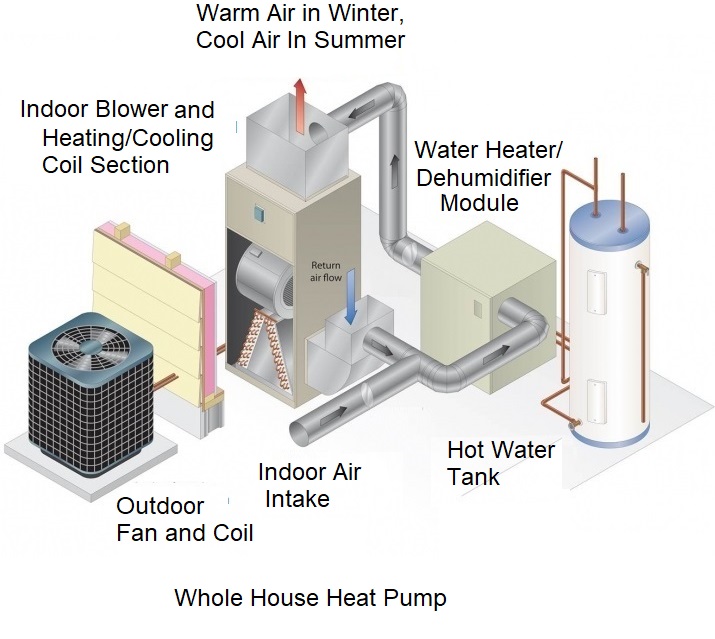
“How does a heat pump transfer heat from outdoors to indoors on a cold day to heat a home?” Explained simply, Freon transfers heat by being pumped through tubes from inside the home to outside and back to the inside. Freon is a gas at
higher temperatures and lower pressures, and a liquid at lower temperatures and higher pressures.
In winter, it is pumped outside in liquid form. The tube expands, causing the pressure to become lower so the Freon becomes a gas. As the tube becomes wider the pressure becomes very low so the gas becomes very cold, colder than the
surrounding air. Since heat flows from hot to cold, heat energy from the outside air flows into the Freon.
The Freon is pumped through the compressor which compresses it to make it a hot liquid, which is pumped into the house. In the house it expands to become a hot gas, which flows through coils. Air is blown past the coils, which heats it, and it is then blown into every room of the house.
To cool the home in summer, a heat pump transfers heat energy from inside the house to the outside by pumping the Freon through the same tubes but in the opposite direction. All of the same components are used. This is called the “refrigeration cycle” which air conditioners use.nnnnnnnnnnnnnnnn
Conventional Whole House Heat Pumps
“How does a heat pump transfer heat from outdoors to indoors on a cold day to heat a home?” Explained simply, Freon transfers heat by being pumped through tubes from inside the home to outside and back to the inside. Freon is a gas at
higher temperatures and lower pressures, and a liquid at lower temperatures and higher pressures.
In winter, it is pumped outside in liquid form. The tube expands, causing the pressure to become lower so the Freon becomes a gas. As the tube becomes wider the pressure becomes very low so the gas becomes very cold, colder than the
surrounding air. Since heat flows from hot to cold, heat energy from the outside air flows into the Freon.
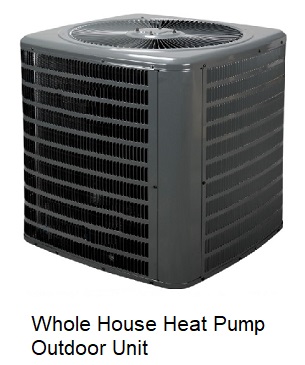
In the past, air-source heat pumps were only appropriate for warmer climates, but in recent years the technology has improved. They’re now cost-effective in some colder regions, such as the upper parts of the Northeast and Midwest. However, an auxiliary heating system is necessary where temperatures drop below 10 degrees F to 25 degrees F, depending on your system’s size.
To The Freon is pumped through the compressor which compresses it to make it a hot liquid, which is pumped into the house. In the house it expands to become a hot gas, which flows through coils. Air is blown past the coils, which heats it, and it is then blown into every room of the house.
To cool the home in summer, a heat pump transfers heat energy from inside the house to the outside by pumping the Freon through the same tubes but in the opposite direction. All of the same components are used. This is called the “refrigeration cycle” which air conditioners use. Conventional whole house heat pump systems are also called “split-system heat pumps”. These are “air-source” because they transfer heat between the house and the outside air. They are called “split-system because some of their components are outside in the yard or on the roof and some are inside. The compressor, fan and outdoor coil is outside, housed in the “outdoor unit” and the indoor coil and blower are inside. They transfer heated or cooled air directly to rooms through HVAC ducts with a register in the wall or ceiling of each room.
New whole house heat pumps can reduce your heating costs greatly over electric furnaces and baseboard heaters and they dehumidify better than standard central air conditioners, so your home will be more comfortable in warmer, muggier months.
They are more energy efficient when the outdoor air is warmer because they draw energy from outdoor to heat the home. Also, they cannot heat the home when the outside air temperature is too low, for some models this is about 35°F. Most have electric resistance heating strips to heat your home on very cold days. They release energy into the outdoor air when they cool the home, so the hotter it is outside the more energy they use to cool the home.
If you presently heat your home with electric heat and your climate is moderate, installing a whole house heat pump system could lower your heating costs by up to 50 percent. In addition, they dehumidify better than standard central
air conditioners. The technology is improving, and consequently the range of temperatures for which they can heat the home efficiently has been increasing. They are now used in relatively cold regions, but back-up electric heat must
be used when the temperature is too cold.
Whole house heat pumps can have a significant problem. Models that are not equipped with “ultraviolet C” (UVC) lights often emit odors. The residents may not realize that the odors are caused by fungus, mold, and bacteria on the coils
of the heat pump. When not controlled by UVC, the fungus, mold, and bacteria can spread throughout HVAC ducts. In addition to emitting unpleasant smells, they can create health problems and cause a reduction in heat pump efficiency.
Mini Split Heat Pumps
Mini split heat pumps, also called “ductless heat pumps” have the basic components of conventional whole house heat pumps. Like whole house heat pumps, they transfer heat energy from the outside to the inside of the house in the winter, and from the inside to the outside in the summer. As a result, they are very expensive to use and not very effective in areas of the country where it is often very cold.
These systems have indoor units mounted high on the walls of one or more of rooms that will be heated and cooled. These “air handlers” create warm and cool air from hot or cold Freon that is pumped in through the wall where they are mounted. There is one outdoor unit for the house, which heats and cools the Freon and pumps it into each of the air handlers. The outdoor unit may be called “compressor/condenser”.
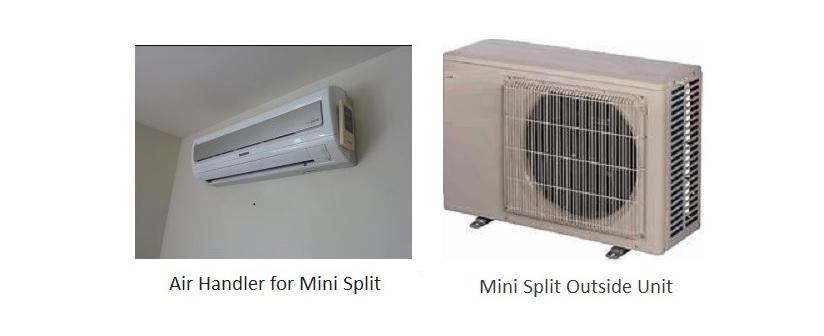
Air handlers draw in air to heat and cool through thin vents at the bottom, and blow it out the top through two registers which are similar to heating registers. Inside the cover is a heat exchanger which looks like a car radiator rolled into a large cylinder. This heat exchanger transfers energy into or out of the Freon into the air.
Their outside unit contains a fan, a compressor and an outdoor coil, as do conventional heat pumps. Refrigerant is heated or cooled in the outdoor unit and pumped through small tubes to the indoor units. The indoor units have tubes running through the wall to drain the condensation water. A mini split heat pump system can have from 0ne to five indoor units. An indoor unit can be installed in a room that is not on an exterior wall.
To install these systems, the installer must cut a 3” diameter hole through the wall of the house behind each unit mounted to the wall. The conduit houses a power cable, refrigerant (Freon) tubing, suction tubing, and a condensate drain tube.
Most models require that a 240v circuit be installed. A cable must be run from the main circuit panel to the outdoor unit, so the cost depends on the distance the cable must run. Also, if your home does not have 200 amps, you may need to do a “heavy-up” to increase its electrical capacity to 200 amps. Models that operate on a 120v circuit are available, but these are less efficient.
The best mini split systems have higher heating and cooling efficiencies, and have many energy-saving features. See Energy Tips for Buying and Using Mini Split Heat Pumps.
Mini split heat pumps are often used when a new room is added to a house that has forced air heating and cooling, and the climate is moderate. They normally use less electricity when heating the room than heating it with space heaters. They may cost about the same to use as cooling with window unit air conditioners, but these block the view through a window.
For maximum efficiency, they should be installed by a heating and cooling technician who can determine the proper size and right product for your home and climate. See Energy Tips for Buying and Using Mini Split Heat Pumps.
The cost of installing a mini split heat pump system is higher than installing other appliances that heat orcool individual rooms, but there may be federal and state tax credits to offset the initial installation cost.
Like conventional whole house heat pumps, they use energy taken from the outdoor air to heat the home, so the warmer the outdoor temperature the more energy efficient they are. Also, they cannot heat the home when the outside air temperature is below about 35°F, depending on the model. Most have electric resistance heating strips for very cold days. When cooling the home, they release energy into the outdoor air, so the hotter it is outdoors, the more electricity they use to cool the home.
They are often chosen because not all of the rooms in the home need to be cooled, or because they can be turned off in rooms when they are not occupied. They do not have the energy loss associated with HVAC ducts, and this loss is very significant in some homes, especially if the ductwork was designed for forced air heat. However, an air handler does not heat and cool a room as efficiently as a whole house heat pump system.
Mini split heat pump systems are now a popular heating and air conditioning choice; mainly to heat and cool a few rooms in homes with no HVAC ducts. They can heat and cool an entire house if the house is relatively small and the climate is moderate. Each indoor unit has its own thermostat, so different rooms can be set at different temperatures and the units can be turned off for periods of the day to save energy. A possible problem is that in some places there are no qualified installers or repair persons.
Their energy efficiency ratings for cooling and heating can be as high as those of whole house heat pumps. These ratings indicate how much hot or cold air is created by how many kilowatt-hrs of electricity.
To install these systems, the installer must cut a 3” diameter hole through the wall of the house behind each unit mounted to the wall. The conduit houses a power cable, refrigerant (Freon) tubing, suction tubing, and a condensate drain tube.
Mini Split Heat Pumps Compared to Conventional Whole House Heat Pumps
If your home is small and you are considering installing a whole house heat pump system with new HVAC ducts, installing a mini split system may be a better choice. It’s cost could be lower and you will have no ducts taking up space all over the house.
If your home has HVAC ducts, a whole house heat pump system should cost less to install, because the mini split systems would have about four inside units, and require that a new circuit be installed to the outside unit. A mini split system could cost much less to operate, however, if you reduce the heating and cooling in areas of the house that aren’t occupied.
If you are considering installing a heat pump system with new HVAC ducts which would run through your attic, ask the contractor to estimate how much energy you would lose through the attic ducts in the cooling season. This could be a significant expense if you live in a hot climate and tip the scale in favor of installing a mini split system. Another factor that could tip the scale is that there may be no qualified mini split installers or repair persons in your area.
Portable Heat Pumps
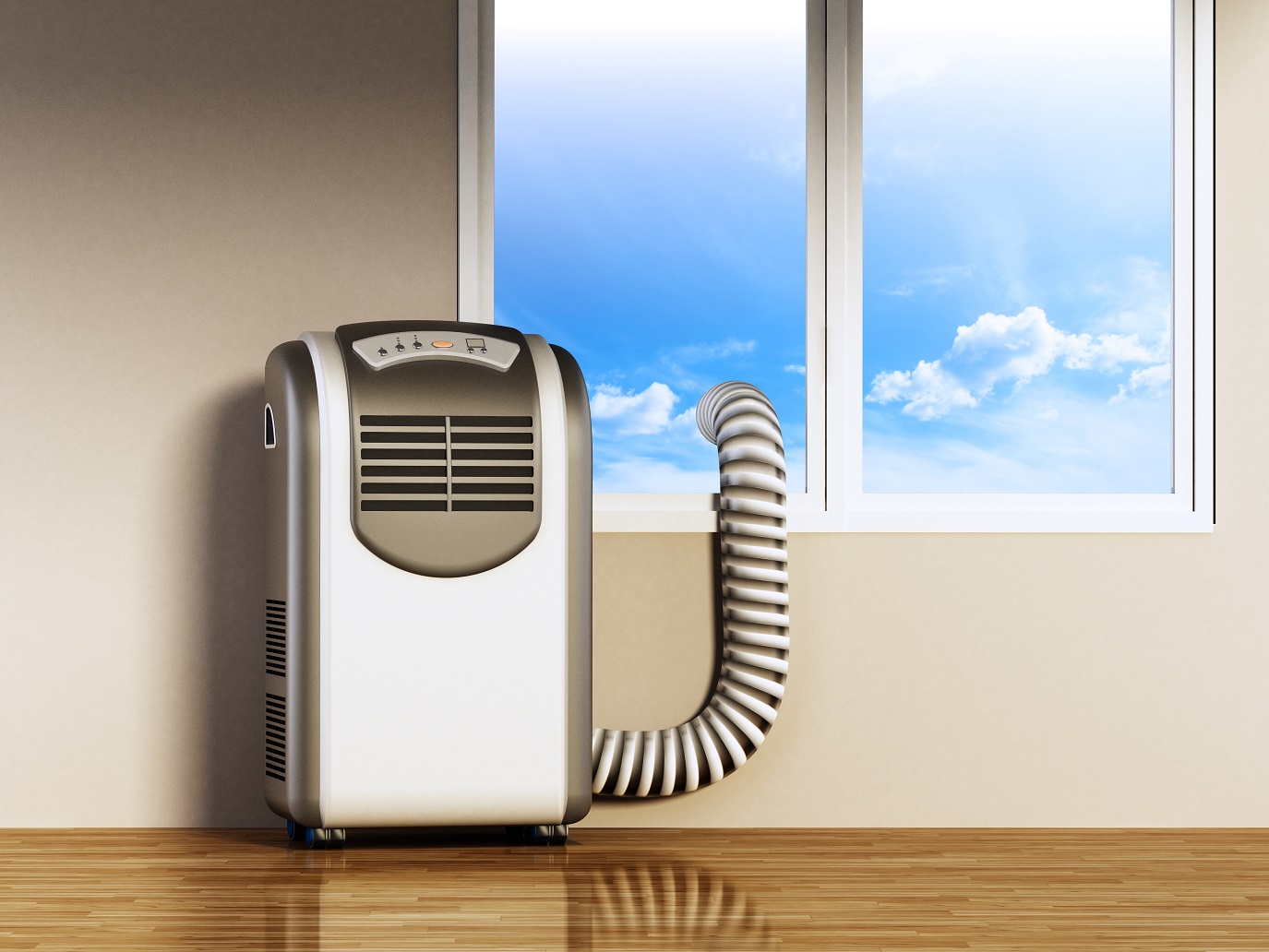
Portable heat pumps have the basic components of whole house and mini split heat pumps combined in one unit. They are on wheels, and can be rolled from room to room, drawing in and exhausting air through the lower sash of a double-hung
window or through a horizontally sliding window. They can save electricity very well if you turn off the central air conditioning and only cool one or two rooms which are occupied.
The largest models are designed to heat and cool one large room. Some models have dehumidifier and fan functions. They begin heating the room quickly, unlike oil-filled electric space heaters, and they cool as quickly as window air
conditioners. Unlike window air conditioners, they allow an open view through the window. At least one brand can be used as an HEPA Air Purifier instead of a heat pump, which is useful when the pollen count is high.
The most efficient portable heat pumps are similar in their cooling efficiencies to the most efficient window unit air conditioners. This is because a heat pump operating in the cooling mode is mechanically similar to an air conditioner. Heat pumps cost much more to buy than window unit air conditioners, so they are only a good investment if they will be used mainly for heating, and only if your outdoor temperature is moderate, so they can be energy efficient.
Their costs range from about $300 to about $1000. Some portable heat pumps are called, “heat pump portable air conditioners”, but these are the same. Heating efficiencies are not often given because a model’s heating efficiency is similar to its cooling efficiency. One high capacity portable heat pump with a dehumidifier function has these technical specifications.
Technical Specifications for a Typical High Capacity Portable Heat Pump
| Cooling Capacity | 13,000 Btu |
| Heating Capacity | 12,500 Btu |
| Power Supply | 115v (60 Hz) |
| Cooling Input | 12A (1350W) |
| Heating Input | 11A (1180W) |
| Dehumidifier | 60 pints/day |
| Sound Level | 47 dB (A) Max |
| Airflow | 225 CFM |
| Product Size | 18.875" wide x 17.125" deep x 32" high |
| Weight | 88 lbs. |
Before buying a portable heat pump, determine if the electrical circuit it would use has enough extra capacity; most circuits do not. An electrical circuit is the wiring that provides power for all of the outlets and lights protected
by one circuit breaker or fuse.
To check which outlets and lights are on a circuit, turn off its circuit breaker or remove its fuse. The lights and outlets that don’t operate are on that circuit. Normally, all of the lights and outlets on a circuit are relatively
close together on the same floor, but there is an exception. A basement outlet may be on almost any circuit in the house because it was added by tapping into a cable that runs through the basement to another part of the house.
A typical portable heat pump requires about 12 amps, and most of the circuits in your home are probably 15-amp circuits, so they would not have enough extra capacity unless they are used for almost nothing else. Most kitchens have outlets on 20-amp circuits, so you could use a 14 gage extension cord from a kitchen circuit.
If an outside circuit is a 20-amp circuit you could run a 14 gage extension cord out the window to it. It is best to hire an electrician to install a 20 amp circuit with an outlet near the window where the heat pump will be used.
A portable heat pump’s efficiency may be given either as an EER value or an SEER value. The EER (Energy Efficiency Ratio) is the ratio of cooling (in Btu/hr) to electrical power (in watts), at 95° outside and 80° inside, with 50% relative
humidity. The SEER (Seasonal Energy Efficiency Ratio) is similar except it is calculated for a typical year’s weather (temperatures and humidities) in a typical location.
The EER for a heat pump is about 87% of it’s SEER. Do not compare the estimated cost of operating a portable heat pump with that of operating a mini-split heat pump by comparing their EER’s or SEER’s because mini-split heat pumps have
larger fans. Their fans blow the heated and cooled air farther into the room. The EPA does not rate portable heat pumps for efficiency or award them an ENERGY STAR® designation.
To help you to buy a model of the right size, to operate the portable heat pump with maximum efficiency, there may be a “sizing guide” printed on the box or in the user’s manual on the website. One manufacturer gives the sizing guide shown below for its products. It is for a room with an average number of sun-exposed windows. If a room has few windows or no sun-exposed windows you could buy a heat pump with a lower cooling capacity.
Sizing Guide for Portable Heat Pumps
| Room Size (sq. ft.) | Cooling Capacity (Btu/hr) |
|---|---|
| 150-200 | 5000 |
| 200-250 | 6000 |
| 250-300 | 7000 |
| 300-350 | 8000 |
| 350-400 | 9000 |
Dual Hose Models Compared with Single Hose Models
Portable heat pumps are either “single hose” or “dual hose”. A dual hose heat pump draws air into the house through one hose, the air is passed through a heat exchanger and blown out through a separate hose. In the winter, this outside air heats cold refrigerant flowing through the heat exchanger. In the summer, it cools hot refrigerant. These cost more but save electricity compared to single hose heat pumps.
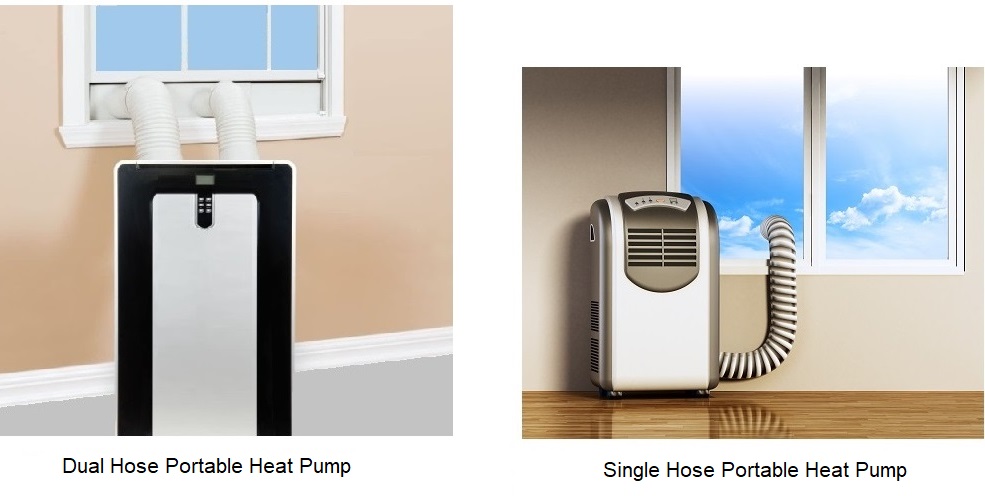
A single hose heat pump blows air from the house through a heat exchanger to outside the house, in all seasons of the year. It is air that has leaked into the house through doors and windows. In summer, the air transfers heat from the heat exchanger to the outside air. In winter the air leaves the house as cold air after transferring its heat to air that passes through the heat pump into the house. A single hose heat pump is much less effective and much less efficient.
Dual hose models have cooling efficiencies in the range of 9 to 10 EER, according to their manufacturers. This is about 10.5 to 11.5 SEER. Dual hose and single hose models are compared below. The best portable heat pumps have several energy-saving features: self-evaporation technology, dual hose design, 3-speed fans, energy-saving thermostats, and dual motor design. A dual hose portable heat pump can be used at a conventional double hung window or at a window with sliding sashes.
You must change the filters regularly to have your portable heat pump to operate efficiently. It will use much more electricity when the filters are dirty. In addition, you should vacuum it inside by following the instructions given in the Use and Care manual.
Water-Source and Ground-Source Heat Pump Systems
Water-source and ground-source heat pump systems are called “geothermal” heat pump systems. They can reduce your home’s energy use and control humidity, while providing they are quiet, long lasting service with little maintenance. A ground-source system has long loops of piping buried in the ground through which refrigerant is pumped. The temperature deep in the ground is between 50º and 60º depending on the season and region of the country.
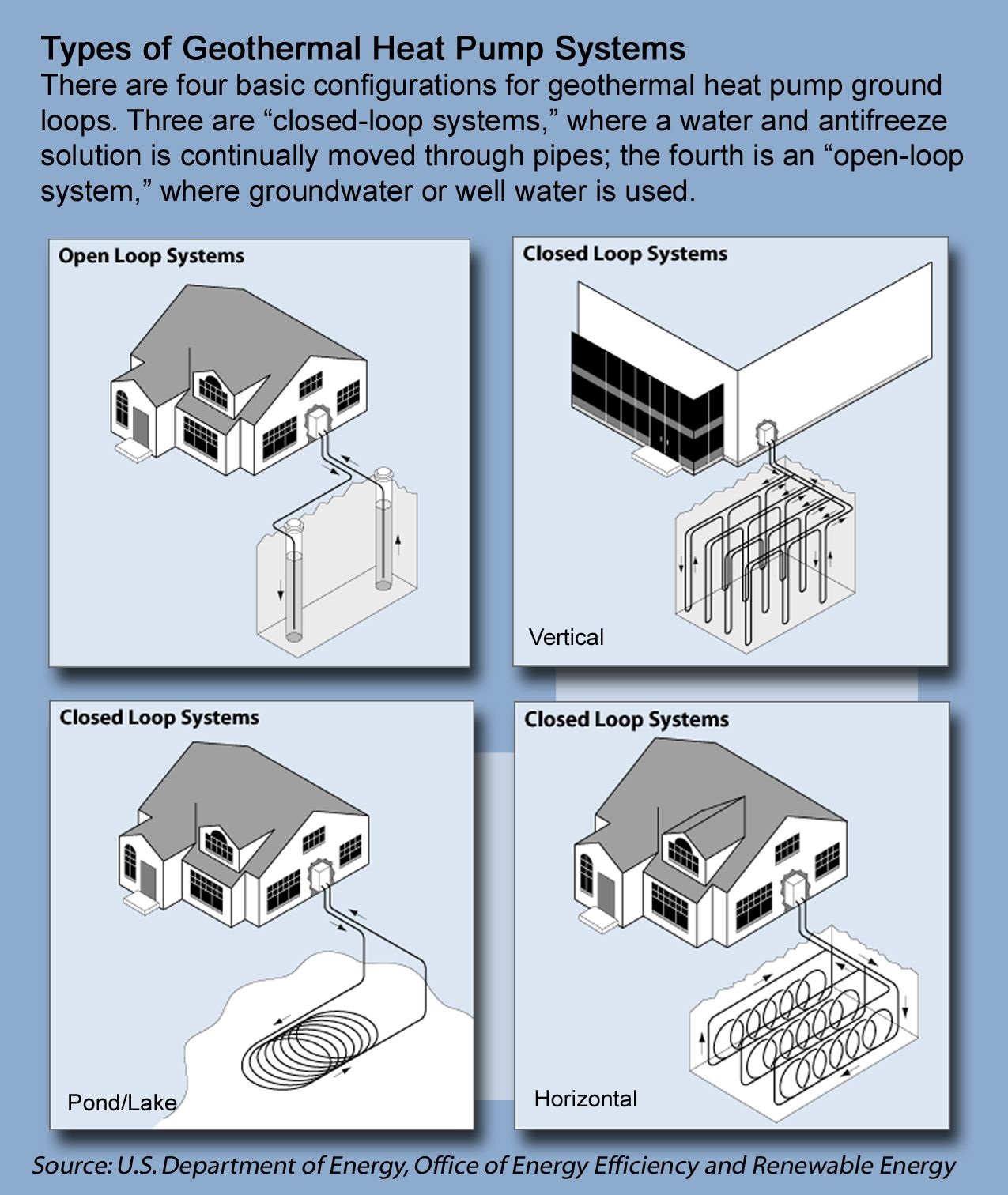
In these systems, the refrigerant is pumped through the piping and enters the evaporator of the heat pump in the house at the temperature under the ground. The refrigerant in the piping absorbs heat in the winter and releases heat in
the summer. The technology is similar to that of conventional air-source heat pump systems but use much less electricity to deliver the same heating and cooling because the ground holds more energy per cubic ft. and energy transfers
more easily from the ground to coolant than from air to coolant.
Since their installation requires much digging, the cost is very high and is seldom used in homes. However, their high efficiency can make ground-source heat pump systems suitable for very large homes.
A water-source heat pump system can be a “lake loop system” or a “well system” (open loop system). A lake loop system has long loops of piping that run along the bottom of a lake or pond and have refrigerant pumped through them.
In a well system, water is pumped from a well or lake through a heat exchanger to absorb energy or add energy to it, then discharges it into a different well or lake. The temperature at the bottom of a deep lake or pond is much cooler than the outside air in the summer and is warmer than the outside air in the winter, so the refrigerant in the piping absorbs heat in the winter and releases heat in the summer.
As with ground source heat pumps, the technology used in water-source heat pump systems is similar to that of conventional air-source heat pump systems but uses much less electricity to deliver the same heating and cooling because heat transfers more easily from water to coolant than from air to coolant. Both types of water-source systems can be good investments if a body of water is close to your house and the climate is moderate.
Geothermal heat pump systems are not practical for small lots or for certain soil conditions, and installation is costly, especially for ground-source systems. However, federal and local incentives can drop the initial cost considerably, and the maintenance and repair costs are much lower than conventional air-source systems.
Whole House Heat Pump Energy Tips
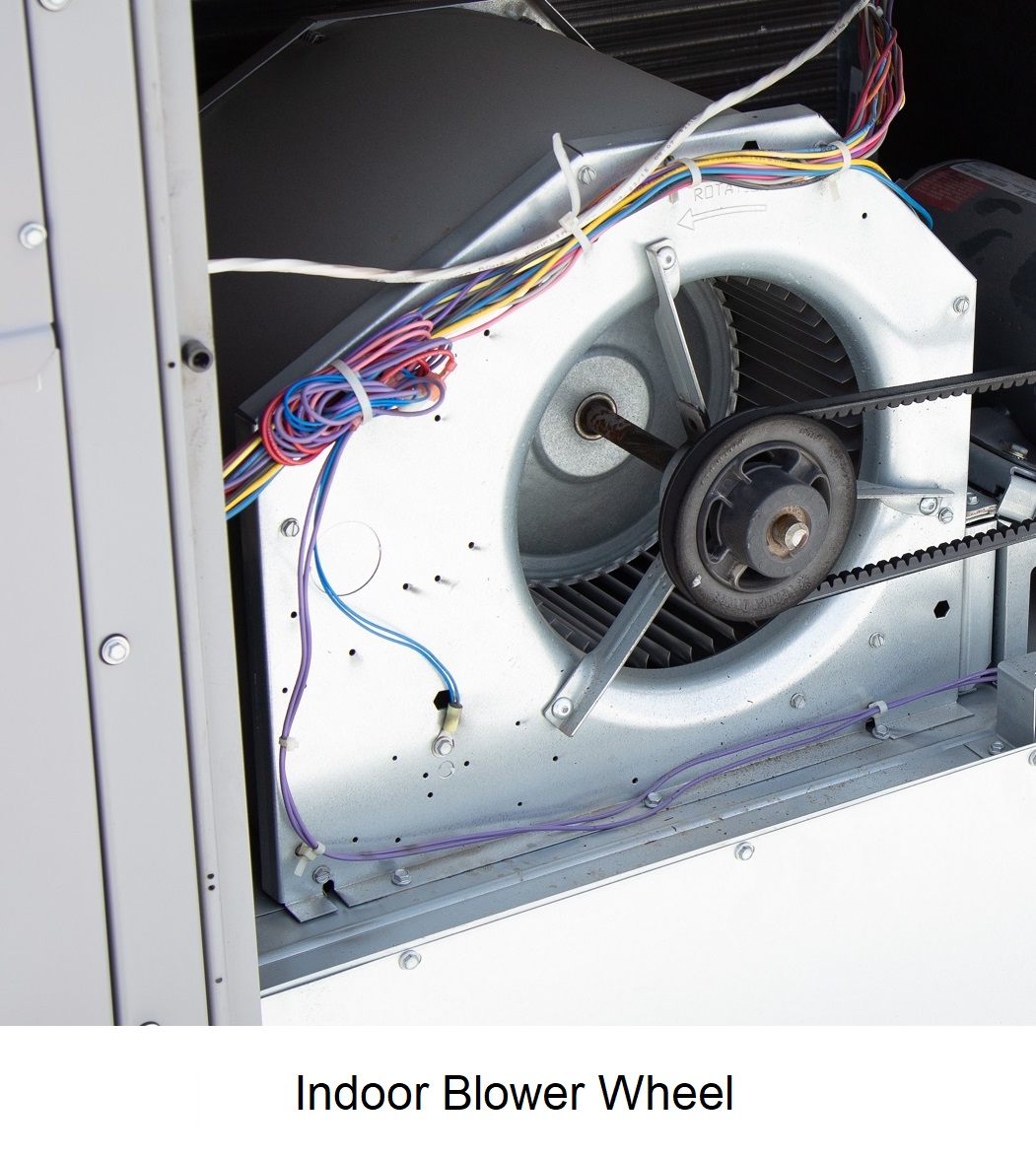

Energy Tips for Buying a Whole House Heat Pump
If you plan to buy a heat pump, there are too many factors to accurately estimate how much electricity you would save. Many of the factors are listed above in Is a Heat Pump Right for You? Some heat pump manufacturers have a “Savings Estimator” on their websites, but this may give exaggerated savings.
A whole house heat pump or mini split heat pump would probably be a good investment if your heating bills are high and your climate is moderate because your air conditioning costs may remain about the same with a heat pump. Your savings from buying a mini-split heat pump would of course be high if you turn off the units in rooms when they are not occupied.
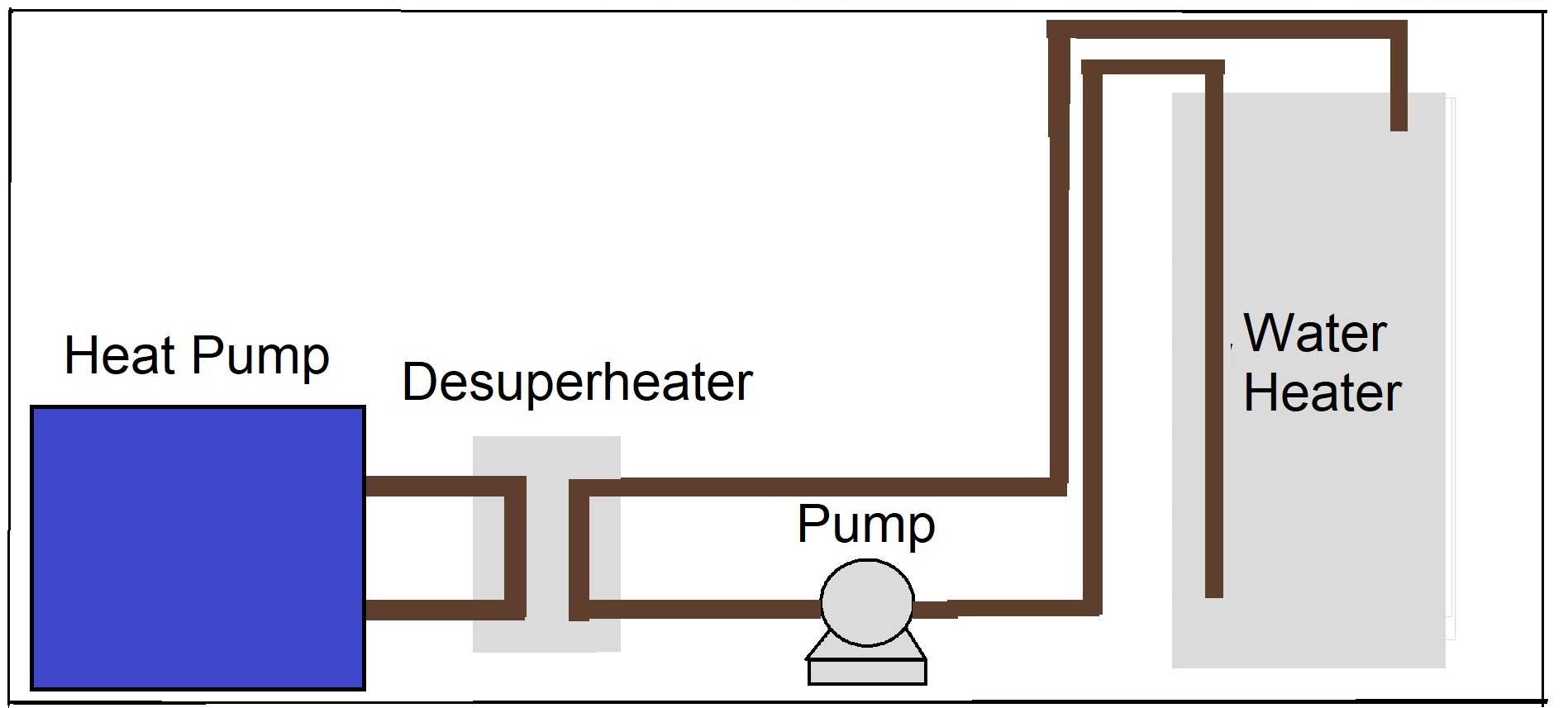
Energy Tips for Buying and Using Mini Split Heat Pumps
Energy Tips for Using Mini Split Heat Pumps
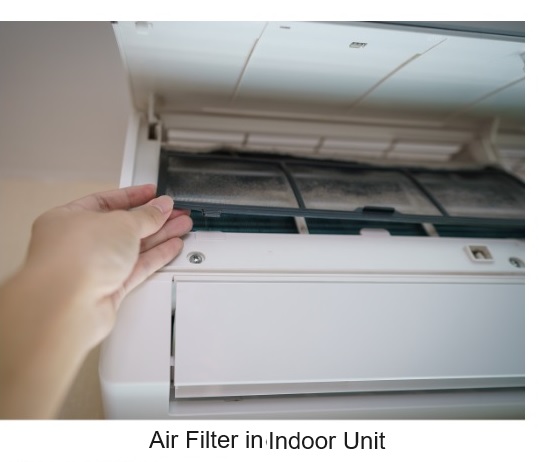
Energy Tips for Buying Mini Split Heat Pumps
Create a Zoned HVAC System for Energy Savings
To save more energy using a heat pump, you could hire an HVAC contractor to install flow control valves, called “dampers” in the HVAC ducts. These allow you to reduce or shut off the heated and cooled air to individual areas of your home. For example, you could shut off the hot or cold air to the second floor during the day and to the first floor at night.
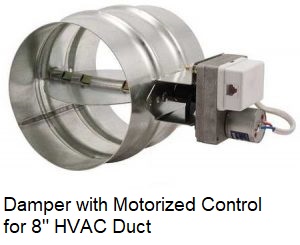
A typical home has two or three branches, often one for each floor. Each branch has an HVAC duct that feeds smaller HVAC ducts, often leading to individual rooms. In a zoned HVAC system, the duct for each branch has a damper to control the airflow going through it. A separate thermostat is installed for each damper, allowing the residents to control that zone (area of the house).
A typical home has two or three branches, often one for each floor. Each branch has an HVAC duct that feeds smaller HVAC ducts, often leading to individual rooms. In a zoned HVAC system, the duct for each branch has a damper to control the airflow going through it. A separate thermostat is installed for each damper, allowing the residents to control that zone (area of the house).
It will cost a few thousand dollars to install dampers throughout your house to create a zoned HVAC system, but you can, of course, spend much less by installing them only in one or two ducts leading to areas where you use less heating and cooling.
A damper is are normally installed to control the airflow through a branch, not an individual room. Installing a damper on a duct that feeds only one room may not lower your energy bills. When it shuts off the airflow to that room, the other registers on that branch would have more air flowing out of them.
Maintenance You Can Do Yourself to Improve the Efficiency of Your Whole House Heat Pump
You can save more energy and lower your utility bills more using your heat pump if you do some simple maintenance that is often recommended for homeowners to do.
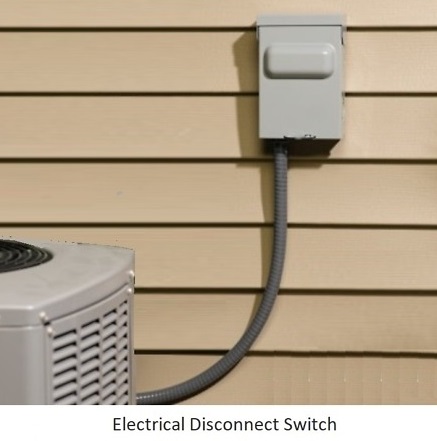
- You must first shut off the power to the heat pump at its electrical disconnect switch. This is outside in a weatherproof metal box, mounted on the wall of the house near the heat pump.
Also, turn off the circuit breaker for the unit in the main electrical service panel. Then, wait a few minutes to allow any stored electrical charge in the unit’s capacitors to dissipate. ssssss ssssss - Remove the cover on top of the and the protective side grille. Be careful not to break any wires. sssssssss sssssss sssssss
- Remove any leaves or pieces of debris from the outside of the coils. Vacuum the coils, being careful not to bend them. Spraying it with a garden hose could bend the coils. ssssss ssssssss sss sssss sssssss
- From inside the outdoor unit, spray water through the coils through to the outside to remove debris. ssssssssss sssssssss s
- If your owner’s manual recommends that you oil the fan motor bearings, do this also.
While the cover and side grille are removed, straighten any bent fins in the outdoor unit. Bent fins restrict air flow, causing the unit run harder, decreasing its energy efficiency so it uses more electricity. Fins are made from delicate thin metal and can be damaged by sticks falling from a tree, hail, or power washing.
A fin comb is used to straighten bent fins in a condensing unit. Both air conditioners and heat pumps have them. These tools may come with single, multiple or interchangeable heads that have different fin comb sizes and counts to best match the coil fin size of the repaired unit.
Some six sided head models will work for 8, 9, 10, 12, 14 and 15 fins per inch coils. The comb is carefully drawn across the bent coil fins straightening them out in the process. They are sold at plumbing stores and can be ordered at some home centers.

How to Build a Roof to Shade Your Heat Pump Condenser Unit
TOOLS:
MATERIALS:
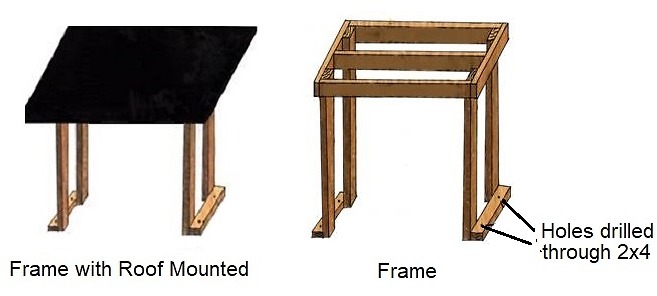
STEPS:
- Cut the pieces of the frame from 2×4’s. The top should have a slight slope and be a foot above the condenser (so heat isn’t trapped) and be large enough to shade the condenser throughout the day. If the condenser is east or west of the house, then the roof should be large enough to shade the condenser when the sun is low. ssssssss ssssssss sssssssssss sssssssssss
- Use 3” deck screws or 12d nails to build the top of the frame and mount the legs. Nail or screw on a piece of 2×4 as a diagonal (not shown on dwg). Place it over the condenser. Drill two ¾” holes through each piece of the frame that rests on the ground, and nail or screw these to the legs (see drawing).sssss ssss sssssssssss ss s sssssssssssssssssssss ssssssssss ssssssssss
- Cut ½” EMT pipe into four 12” pieces to use as stakes, with one end of each cut to 45º to penetrate the ground. Flatten 1” of the other end with a sledgehammer and bend it over. This end will hold down the board. Pound the stakes through the holes until the ends rest on the boards. sssssssssss ssss ss ssssssssss sssssss
- Using 1/2” plywood or 1” boards, cut the wood for the roof. Fasten it to the frame using 8d nails or 2” screws. sssssssssssssssss sssssssss sssssssssss ssssssssss sssssssss
- Cut the shingles with a utility knife and nail them to the roof with ¾” roofing nails.
Heat pumps are complicated, but in simple terms, they move heat energy from outside to inside in winter and from inside to the outside in summer, lowering your utility bills. Buy a whole house heat pump or a smaller model if your climate is moderate and use these energy tips and you will save money using a heat pump.

No Responses